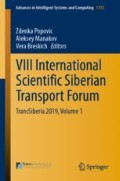Abstract
The problem of the increased potential of the rail-ground with the flow of electric trains reverse traction current operating in the area of the AC feeder is considered. The studies were caused by the need to ensure the electrical safety of the staff and the infrastructure facilities reliability when passing trains of increased weight. In the process of experimental studies of the high potentials causes in rail circuits, data were obtained indicating the complex nature of the electromagnetic interaction of reverse current harmonics with rail circuits. For studies of electromagnetic compatibility between railway subsystems, it requires the use of simulation programs that help to reveal most critical conditions for electromagnetic compatibility conditions, and allow the evaluation of electromagnetic interference from rolling stock in rails in the worst conditions. A developed the traction current harmonics distribution model in the rails is considered in this paper. The traction current harmonics distribution in the rails was calculated for a direct AC power supply of 25 kV depending on the distance from the power supply substation, the conductivity of the railway and the ground and the number of trains in the feeder zone. The results of the harmonics distribution simulation are in satisfactory agreement with the experimental data and will allow the technical measures development to reduce the rail-ground potential.
Access this chapter
Tax calculation will be finalised at checkout
Purchases are for personal use only
References
Shamanov, V.: The magnetic properties of rail lines and level of interferences for the apparatus of automatic control and telemechanics. Russ. Electr. Engin. 86, 548–549 (2015). https://doi.org/10.3103/S1068371215090102
Colella, P., Pons, E., Tortora, A.: Rail potential calculation: impact of the chosen model on the safety analysis. In: AEIT International Annual Conference, 18346905 (2018). https://doi.org/10.23919/aeit.2018.8577295
Mariscotti, A.: Induced voltage calculation in electric traction systems: simplified methods, screening factors, and accuracy. IEEE Trans. Intell. Transp. Syst. 12, 201–210 (2011). https://doi.org/10.1109/TITS.2010.2076327
Godyaev, A., Onischenko, A.: Automated monitoring of level distortion coded signals transmitted on rail line. In: International Multi-Conference on Industrial Engineering and Modern Technologies (FarEastCon), 18393174 (2018). https://doi.org/10.1109/fareastcon.2018.8602696
Rui, P., Mingli, W., Shaobing, Y.: Performance of the integrated grounding system of Hefei-Nanjing passenger dedicated railway. In: International Conference on Sustainable Power Generation and Supply, SUPERGEN 2009, 11001154 (2009). https://doi.org/10.1109/supergen.2009.5348003
Ogunsola, A., Mariscotti, A.: Electromagnetic Compatibility in Railways, p. 528 (2013). https://doi.org/10.1007/978-3-642-30281-7
Matta, V., Kumar, G.: Unbalance and voltage fluctuation study on AC traction system. In: Electric Power Quality and Supply Reliability Conference (PQ), pp. 303–308 (2014). https://doi.org/10.1109/pq.2014.6866831
Shamanov, V.: Formation of Interference from Power Circuits to Apparatus of Automation and Remote Control. IEEE East-West Design & Test Symposium (EWDTS), 18248723 (2018). https://doi.org/10.1109/ewdts.2018.8524676
Stell, R.W.B.: Maximum permissible rail potential. IEEE Veh. Technol. Mag. 6, 12206592 (2011). https://doi.org/10.1109/MVT.2011.942537
Tetiana, S., Vitaliy, K., Yevheniia, K.: About electromagnetic compatibility of rail circuits with the traction supply system of railway. In: IEEE 3rd International Conference on Intelligent Energy and Power Systems (IEPS), 18323445 (2018). https://doi.org/10.1109/ieps.2018.8559541
Bellan, D., Spadacini, G., Grassi, F., Fedeli, E., Pignari, S.A.: Modeling strategies for conducted and radiated emissions in high-speed railway lines. In: Asia-Pacific Symposium on Electromagnetic Compatibility (APEMC), 15670514 (2013). https://doi.org/10.1109/apemc.2013.7360635
Mirzaei, M., Ripka, P.: Analysis of material effect on rail impedance. In: 53rd International Universities Power Engineering Conference (UPEC), 18319950 (2018). https://doi.org/10.1109/upec.2018.8541860
Havryliuk, V.: Modelling of the return traction current harmonics distribution in rails for AC electric railway system. In: International Symposium on Electromagnetic Compatibility (EMC EUROPE), pp. 251–254 (2018). https://doi.org/10.1109/emceurope.2018.8485160
Serdiuk, T.: Modeling of influence of traction power supply system on railway automatics devices. In: International Symposium on Electromagnetic Compatibility - EMC EUROPE, 17337406 (2017). https://doi.org/10.1109/emceurope.2017.8094637
Serdiuk, T., Feliziani, M., Serdiuk, K.: About electromagnetic compatibility of track circuits with the traction supply system of railway. In: International Symposium on Electromagnetic Compatibility (EMC EUROPE), 18149852 (2018). https://doi.org/10.1109/EMCEurope.2018.8485034
Baranovskii, A.: Computer simulation and experimental investigations of noise levels and spectra for railway transport. Autom. Control Comput. Sci. 45, 293–294 (2011). https://doi.org/10.3103/S0146411611050026
Charalambous, C., Cotton, I., Aylott, P.: Modeling for preliminary stray current design assessments: the effect of crosstrack regeneration supply. IEEE Trans. Power Deliv. 28, 13596015 (2013). https://doi.org/10.1109/TPWRD.2013.2259849
Tryapkin, E., Ignatenko, I., Keino, M.: Development of “digital substation” technology for power supply of railways. Siberian Transport Forum – TransSiberia. In: MATEC Web Conferences, vol. 239, p. 01051 (2018). https://doi.org/10.1051/matecconf/201823901051
Acknowledgment
We express our deep gratitude to all our colleagues, authors of the works, familiarization with which greatly helped us in conducting research and obtaining relevant results, although they may not agree with all our interpretations and conclusions.
Author information
Authors and Affiliations
Corresponding author
Editor information
Editors and Affiliations
Rights and permissions
Copyright information
© 2020 Springer Nature Switzerland AG
About this paper
Cite this paper
Ignatenko, I., Tryapkin, E., Vlasenko, S., Onischenko, A., Kovalev, V. (2020). Impact of Return Traction Current Harmonics on the Value of the Potential of the Rail Ground for the AC Power Supply System. In: Popovic, Z., Manakov, A., Breskich, V. (eds) VIII International Scientific Siberian Transport Forum. TransSiberia 2019. Advances in Intelligent Systems and Computing, vol 1115. Springer, Cham. https://doi.org/10.1007/978-3-030-37916-2_13
Download citation
DOI: https://doi.org/10.1007/978-3-030-37916-2_13
Published:
Publisher Name: Springer, Cham
Print ISBN: 978-3-030-37915-5
Online ISBN: 978-3-030-37916-2
eBook Packages: EngineeringEngineering (R0)

